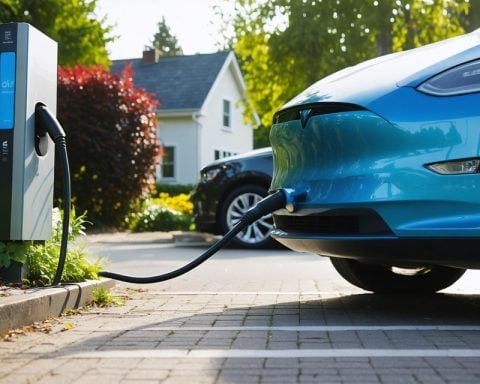- Türkiye sees a rise in electric vehicle (EV) adoption, straining apartment infrastructure with makeshift charging stations.
- Improvised setups, featuring unsecured cables, pose significant fire hazards in high-density living complexes.
- Residents bypass official protocols, complicating safety enforcement and increasing risks of accidents.
- The Ministry of Environment, Urbanization, and Climate Change is working on regulations for legal EV charging installations in shared spaces.
- Site managers face challenges due to inadequate enforcement mechanisms and legal loopholes, leaving safety initiatives stagnant.
- Despite these challenges, EV sales continue to soar, comprising 11.1% of the market by January 2025.
- Safety advocates demand robust regulatory policies to safely integrate home charging solutions and prevent future disasters.
The tranquil hum of electric cars sweeping across Türkiye belies a growing concern looming over apartment complexes: the threat of fiery disasters ignited by makeshift EV charging stations. With vibrant enthusiasm, citizens embrace eco-friendly vehicles, yet a shadow is cast as residents bypass official protocols, leaving extended power cables snaking through stairwells and corridors—a reckless move courting catastrophe.
In high-rises, the sight of cords precariously danging down from the densely-packed floors disturbs the nation’s tranquil skyline. Residents, eager to gain a foothold in an electric future, often install these makeshift stations without necessary authorizations, throwing caution—and safety—to the wind.
Though Türkiye’s Ministry of Environment, Urbanization, and Climate Change diligently rolls out regulatory advances to facilitate legal installation in shared lots, enforcement is frustratingly feeble, akin to a loose tether. The power to regulate rests with site managers, who, burdened by inadequate oversight and enduring legal loopholes, grapple with securing a majority consensus among residents to enforce safety measures. Complaints about unapproved stations often echo unanswered, leaving site managers bearing the weight of potential liabilities.
Despite the risks, EV sales skyrocket, with electric models surging to capture 11.1% of the January 2025 market. Yet, while public stations bloom across urban landscapes, home chargers remain a thorny issue. As infrastructure trundles to broader accessibility, unregulated setups threaten to tarnish Türkiye’s electric revolution.
With every buzz of an electric motor, safety advocates call for robust regulatory policies to avert tragedy. The picturesque avenues of Türkiye might soon whip up more than a technological storm, unless swift and decisive action shores up this invisible peril—transforming electric dreams into a truly bright, and safe, future.
Are Türkiye’s Makeshift EV Charging Stations Leading to a Looming Disaster?
How-To Steps & Life Hacks for Safe EV Charging
To mitigate the risks associated with makeshift charging setups in apartment complexes, follow these steps:
1. Contact Property Management: Before installation, communicate with building management to understand any existing procedures for EV charger installations.
2. Understand Local Regulations: Research Türkiye’s regulatory framework for EV charger installations in shared residential areas, as this often includes guidelines and approved equipment lists.
3. Consult Professionals: Employ licensed electricians to ensure installations meet safety standards, preventing hazards like electrical fires.
4. Install Safety Protocols: If installation is approved, integrate safety features like circuit breakers and surge protectors to mitigate potential risks.
5. Community Voting: Advocate for a democratic voting process within the housing association to approve communal EV charging installations.
Real-World Use Cases and Challenges
In many countries, including Türkiye, EV drivers in apartment complexes face similar challenges. In cities like Istanbul, public charging stations remain plentiful, yet residents often need private solutions. Mismanaged setups can lead to not just electrical issues, but also physical obstructions and disputes among residents.
Market Forecasts & Industry Trends
The electric vehicle market in Türkiye is projected to expand significantly, particularly after 2025, with further adoption of green energy policies and infrastructure development. The global EV market is also set to continue its robust expansion, aiming for a 29% compound annual growth rate (CAGR) by 2030 (Source: International Energy Agency).
Features, Specs & Pricing
The current trend is moving towards highly intelligent and compact charging systems that incorporate safety and efficiency. Products like wall-mounted chargers cost around $500-$1,200, varying by technology and features such as fast charging and Wi-Fi connectivity.
Security & Sustainability
Security is a major concern when it comes to unauthorized installations due to the risk of electrical fires and energy theft. Sustainability, however, is a key driver, with many EV chargers now supporting solar and other renewable energy sources.
Reviews & Comparisons
Countries like Norway and the Netherlands provide comprehensive legislative frameworks for EV infrastructure, and serve as excellent models for Türkiye. Their success is rooted in government incentives combined with strict building codes.
Controversies & Limitations
Legal loopholes and lack of enforcement in Türkiye contribute significantly to safety issues. This is compounded by an insufficient supply of licensed technicians to manage the growing demand for installations.
Pros & Cons Overview
Pros:
– Environmental benefits.
– Lower running costs compared to gasoline vehicles.
Cons:
– Safety risks with improper installations.
– Initial setup costs can be prohibitive.
Actionable Recommendations
1. Initiate Building-Wide Plans: Propose an official plan for safe charging infrastructure within your complex.
2. Leverage Incentives: Look for government subsidies and incentives that reduce installation costs.
3. Educate Fellow Residents: Raise awareness about the risks of unauthorized setups for a safer community standard.
For more insights on EV infrastructure advancements, visit International Energy Agency for global trends and detailed reports.













